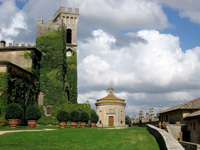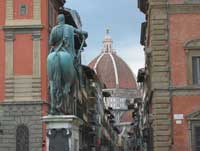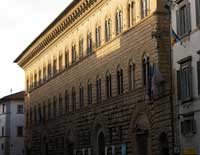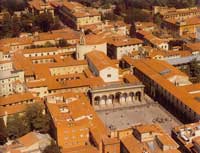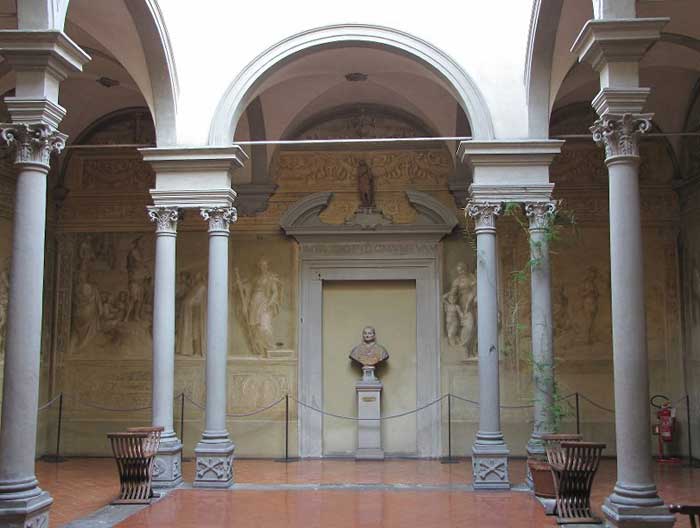 |
| Andrea del Sarto, frescoes in the Chiostro dello Scalzo, Florence |
Andrea del Sarto | Chiostro dello Scalzo |
| The Chiostro dello Scalzo is one of the most delightful cloisters in Florence and the cycle of frescoes by Andrea del Sarto on ‘The Life of St John the Baptist’ is certainly one of the most original. |
|
||
Baptism of the People |
||
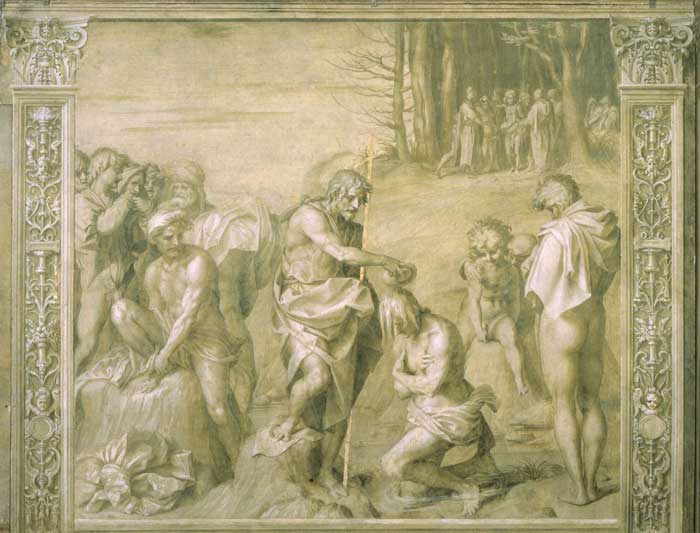 |
||
Andrea del Sarto, Battesimo Della Gente, one of Andrea del Sarto's gray and brown grisaille frescoes in the Chiostro dello Scalzo, Florence (1511-26). |
||
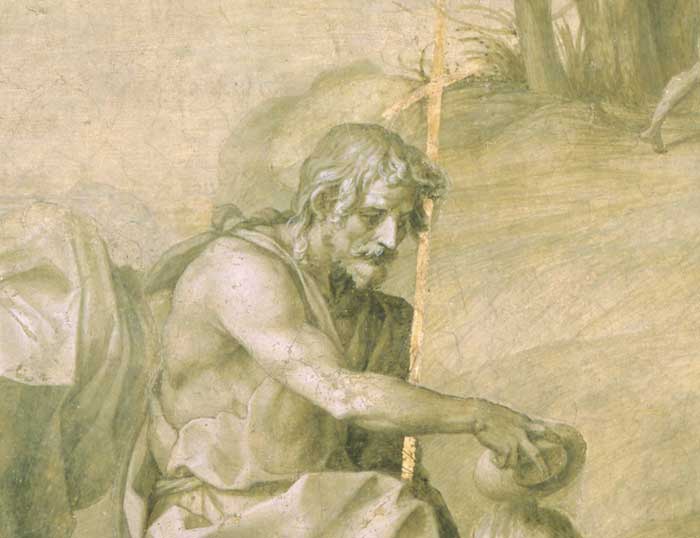 |
||
Andrea del Sarto, Baptism of the People (detail), 1515-17, fresco, Chiostro dello Scalzo, Florence |
||
In Andrea del Sarto's hands, the use of monochromatic pigments in this fresco creates an almost silvery aura. The subject of the Baptism of the People offered a challenge appropriate to a painter of his generation and of his innate skills. The emphasis is upon the rendering of the figure and in particular the nude in a variety of poses and states of undress, consistent with the subject matter. |
||
| Address: Chiostro dello Scalzo, Via Cavour 69. Open Mon, Tue, Sat 8,15am-1.50pm. Admission: free. |
||||
| [1] Grisaille Grisaille ( 'grey') is a term for painting executed entirely in monochrome or near-monochrome, usually in shades of grey. It is particularly used in large decorative schemes in imitation of sculpture. Many grisailles in fact include a slightly wider colour range, like the Andrea del Sarto fresco illustrated. Paintings executed in brown are sometimes referred to by the more specific term brunaille, and paintings executed in green are sometimes called verdaille.[1] A grisaille may be executed for its own sake, as underpainting for an oil painting (in preparation for glazing layers of colour over it), or as a model for an engraver to work from. "Rubens and his school sometimes use monochrome techniques in sketching compositions for engravers."[2] Full colouring of a subject makes many more demands of an artist, and working in grisaille was often chosen as being quicker and cheaper, although the effect was sometimes deliberately chosen for aesthetic reasons. Grisaille paintings resemble the drawings, normally in monochrome, that artists from the Renaissance on were trained to produce; like drawings they can also betray the hand of a less talented assistant more easily than a fully coloured painting. Giotto used grisaille in the lower registers of his frescoes in the Scrovegni Chapel, and Robert Campin, Jan van Eyck and their successors painted grisaille figures on the outsides of the wings of triptychs, including the Ghent Altarpiece. Originally these were the sides on display for most of the time, as the doors were normally kept closed except on feast days or at the (paid) request of tourists. However today these images are often invisible in museums when the tryptych is displayed open and flat against a wall. In these cases imitation of sculpture was intended; sculpture was still more expensive than a painting even by a top master. Illuminated manuscripts had often been produced in pen and wash with a very limited colour range, and many artists such as Jean Pucelle and Matthew Paris specialised in such work, which had been especially common in England since Anglo-Saxon times. Renaissance artists such as Mantegna and Polidoro di Caravaggio often used grisaille as a classicising effect, either in imitation of the effect of a classical sculptured relief, or of Roman painting. In the Low Countries a continuous tradition of grisaille paintings can be traced from Early Netherlandish painting to Martin Heemskerck, Pieter Brueghel the Elder (Christ and the Woman Taken in Adultery) and Hendrik Goltzius, and through the copious output of Adriaen van de Venne, to the circle of Rembrandt, and Jan van Goyen. The ceiling frescoes of the Sistine chapel have portions of the design in grisaille. At Hampton Court the lower part of the decoration of the great staircase by Antonio Verrio is in grisaille. Grisaille, while less widespread in the 20th century, continues as an artistic technique. Picasso's Guernica is one example of a contemporary painting in grisaille. |
|
|||
|
This article incorporates material from the Wikipedia article Grisaille published under the GNU Free Documentation License. |
||||
Holiday accomodation in Toscany | Podere Santa Pia | Artist and writer's residency
|
||||
Podere Santa Pia |
Podere Santa Pia, garden view, December |
View from terrace with a stunning view over the Maremma and Montecristo |
||
 |
||||
Villa Celsa near Florence |
Piazza della Santissima Annunziata in Florence |
Siena, Duomo |
||
Palazzo Medici Riccardi, Florence |
Piazza della Santissima Annunziata in Florence |
Florence, Duomo |
||
The technique of fresco painting |
||||
| The technique of fresco painting consists of painting colour pigments onto a layer of plaster that is still wet or "fresh" as the Italian term fresco suggests. Walls to be frescoed were normally constructed from a single material, generally stone or brick to prevent damage to the frescoes from any movement in the wall due to settlement. The artist would begin by applying a layer of plaster, made from a mixture of water, slaked lime, and large-grained river sand, to the wall. This first layer, known as the arriccio, was applied to a thickness of one centimetre. The surface had to be very rough to allow the second layer of plaster to adhere to it easily. On top of the arriccio, the outline of the fresco was drawn in charcoal, which was then erased using feathers after a second outline had been applied in ochre. Over the ochre, another outline was added with a red pigment called sinopia, a term which came to be used to describe the preparatory drawings it was used for. Finally, a fine layer of plaster called intonachino or velo was applied. This was transparent and much smoother than the arriccio and was usually made from one part slaked lime and two parts finely-ground sand. The surface had to be perfectly smooth surface and remain wet throughout the entire painting process and was therefore only applied to an area that the artist could complete painting in one day. For this reason, each one of these sections came to be known as a giornata, or 'day's work'. The painter began by copying the sinopia outline, which showed through from the layer underneath, onto the wet plaster, and then started to paint using ground pigments mixed with water. Faces were usually painted starting with light shades and progressing to darker ones. The opposite technique was used for clothing, in which dark shades followed lighter ones. Not all pigments could be used. Indeed, when the plaster dries, the lime which it contained causes a chemical reaction called carbonation, which releases heat and can burn plant-based pigments. For this reason, some touching up was often required after the plaster had dried to perfect details. This technique is called a secco, or dry. Blues, too, had to be painted a secco. This was true for both the extremely costly lapis lazuli or ultramarine, and azurite or "German blue". By the mid 15th century, the sinopia technique began to be replaced with preparatory cardboard, or cartone. The drawings were done to a smaller scale on squared paper in the artist's workshop. A larger-scale grid with the same number of squares was then drawn on a piece of paper the same size as the fresco. The smaller drawing was then copied onto the large one, enlarged square by square. Holes were poked in the large drawing using a big needle and a loosely-woven sack of coal dust was passed over it. This technique, known as spolvero or dusting, resulted in a continuous series of little dots which the artist would join together to create the drawing. During the Renaissance a third method was also developed in which the drawing, enlarged using the grid method, was transferred onto thin paper. This was laid over the fresh plaster and a long nail was used to trace the lines and transfer the composition onto the mortar. Serena Nocentini | The technique of fresco painting | www.brunelleschi.imss.fi.it | Watch the movie |
||||

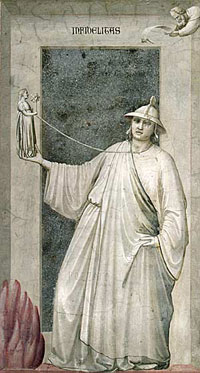 Giotto, Scrovegni Chapel, The Seven Vices, Infidelity
Giotto, Scrovegni Chapel, The Seven Vices, Infidelity


